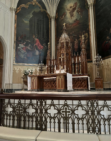How are the images, music, and material culture of Catholicism used to construct political attitudes and racialized ideas of nationhood? While there has been a flurry of media and scholarly attention to “Christian nationalism” and white evangelical racism, less attention has been paid to conservative (liturgically and/or politically) traditionalist Catholic communities. Trads are often defined as Catholics who prefer the liturgy and social teaching from before the Second Vatican Council (1962-1965). Some associate trads with an affinity for the Latin Mass and Gregorian chant, while others focus on their often right-wing political leanings. To explore the connection between these two images of trads, I speak with a scholar of Catholic communities, Dr. Tricia Bruce, as well as two self-identified trads, Fr. Garrett O’Brien and Scarlett.
Dr. Bruce’s recent book, Parish and Place, documents the American Catholic Church’s movement away from territorial parishes and towards personal parishes as a renewed organizational form. While the majority of personal parishes serve ethnic Catholics (Bruce profiles Hispanic and Vietnamese parishes in the book) who desire, among other things, to hear mass and have fellowship in their native language, I ask how concepts of whiteness contribute to the imagination of the “tradition” in traditionalist, or Latin Mass, parishes. This conversation addresses two major questions: first, how do these particular imaginings of “tradition” also create ideas about race, nation, and civilization? Or, to put in another way, how do ideas about race map onto notions of “tradition” and the legacy of Latin in the Catholic Church? Second, how does the use of these images and materials work in the particular context of New Orleans? What historical and contemporary tensions are people responding to?
Some trads on Catholic Twitter share images of knights, medieval martyrs, and five-fold crosses, constructing and valorizing a particular vision of white “Western” civilization. But we also see traditionalist Catholics espousing political ideas from monarchism to libertarianism, from socialism to anarchism. Online “trads” draw upon different items from the archive of Catholicism’s past, often held together in tension with one another, some of which are authorized by the Church’s leadership while others are not. In order to focus some of these broader questions on race, democracy, and tradition on a particular place, I traveled to New Orleans where I visited two Catholic parishes and compared how these spaces remembered the “secular” history of New Orleans. First, I visited the historic St. Patrick’s Church in Lafayette Square, a traditionally Irish parish constructed in direct opposition to the French-controlled St. Louis Cathedral. This is now a traditionalist parish that offers the Latin Mass daily. Second, I visited St. Augustine Church, the oldest Black Catholic church in the United States.
While the visual and liturgical culture of St. Patrick’s was mobilized to construct a Eurocentric idea of tradition that sacralized the medieval and early modern period, St. Augustine’s monuments told a story of enslaved Louisianans and free people of color, and their Jazz mass sacralized the music of African-American communities of New Orleans during the 19th and 20th centuries.
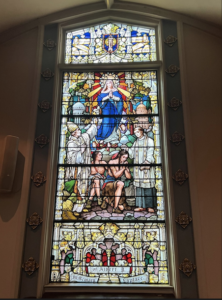
Stained glass window of St. Patrick’s Church, depicting the conversion of Indigenous Americans.
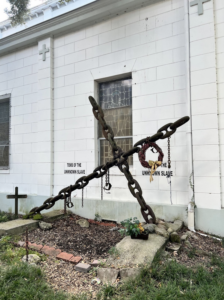
Tomb of the Unknown Slave outside St. Augustine Church, New Orleans.
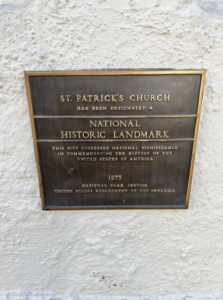
National landmark plaque outside the front doors of St. Patrick’s Church.
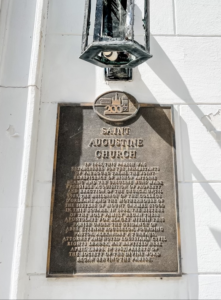
Plaque Outside of the front doors of St. Augustine Church, New Orleans.
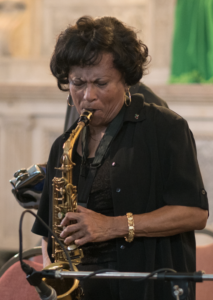
Jazz Mass in St. Augustine Church, New Orleans.
While the particular racial and political history of New Orleans is memorialized differently in the two parishes of St. Augustine’s and St. Patrick’s, the broader question that kept popping up in these conversations seemed to be what past–indeed whose past– is considered sacred. How do spaces, rituals, and monuments create ideas of Tradition that stand outside of history to be presented as universal? Dr. Bruce, Fr. O’Brien, and Scarlett all highlighted how the draw of traditionalism in parishes is how it makes one feel separate from the world. Begging the question, what gets seen as “worldly” and what gets seen as sacred? What gets labeled “culture” and what is elevated to universal divine timelessness? It seems that the key to understanding the fluid, complex, and sort of invented nature of the “trads,” is to think about how “tradition” is manufactured in the first place.
Additional Credits

Tricia C. Bruce, Ph.D. is a sociologist, researcher, and award-winning author of several books and high-impact research reports. Her areas of expertise include religion (specializing in U.S. Catholicism), polarization, abortion attitudes, congregations, and social change. She is an affiliate of the University of Notre Dame’s Center for the Study of Religion and Society.
Thanks also to Jordan Johnson, voice actor.
Additional Resources
Tricia Bruce, Parish and Place: Making Room for Diversity in the American Catholic Church (Oxford University Press, 2017).
Tara Isabella Burton, “Christianity Gets Weird: Modern life is ugly, brutal and barren, maybe you should try a Latin Mass,” Opinion, New York Times, May 8, 2020. https://www.nytimes.com/2020/05/08/opinion/sunday/weird-christians.html.
Tara Dudley, Building Antebellum New Orleans: Free People of Color and Their Influence (University of Texas Press, 2021).
Lauren Horn Griffin, ““The Infant Jesus of Prague and the Catholic Presence on January 6,” Uncivil Religion: January 6, 2021 (accessed January 2023).
Lauren Horn Griffin, “The Illusion of RadTrad Identity,” American Examples: New Conversations about Religion, Volume Three (University of Alabama Press, 2024).




